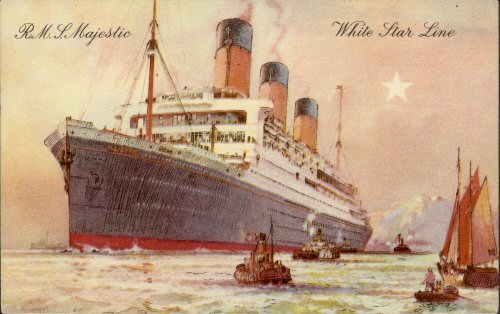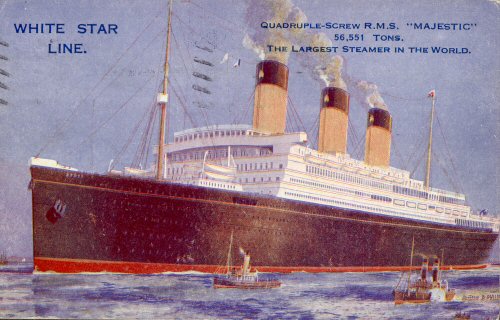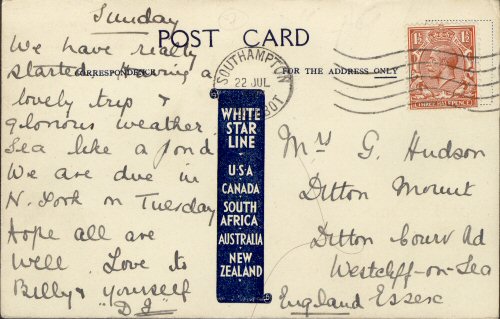
The Bismarck During the War
The "Bismarck" was the most unfortunate of the three ships. Whereas the "Imperator" had at least seen a couple of years of actual service and was then idle in friendly waters and the "Vaterland" after only a few crossings had been trapped in a neutral, later hostile, harbor, the largest of the trio was not even completed when war broke out. Her launching on June 20, 1914 was one of the most celebrated maritime events of the time, but only eight days later the gunshots at Sarajevo killed the Austrian Archduke Ferdinand, leading to war within a month.
Throughout the war, the "Bismarck" sat at her builders' yard, "a rusting shell of what was intended to be the world's largest ship and the flagship of the German merchant fleet." There were rumors that the liner was to be completed and would be used to carry the entire Imperial family on an around-the-world victory cruise. The "Bismarck" again stood for dozens of new liners that were awaiting completion in German shipyards when war broke out, among them the new "Columbus" (later White Star's "Homeric") and "Hindenburg" of the North-German Llloyd, both almost 40,000 tons large.
The Bismarck after the War
The Hamburg-Amerika-Line was never able to enjoy the third and largest of its supertrio. Hopes that the liner, which had sat at the Blohm & Voss shipyards throughout the war, would be completed to reactivate German transatlantic service were soon shattered. The Allies had other plans. The Treaty of Versailles ordered the Germans to complete the ship and hand it over to the British government. Construction was delayed by deliberate slowness on the part of the reluctant work crews and shortages of steel so that it took until May 1922 to complete the world's largest ship. When staff members of the White Star Line, the "Bismarck's" new owners, arrived in Hamburg, they found the funnels painted in Hamburg-America colors and the name "Bismarck" on the bow. The shipyards workers had also converted the captain's cabin into a garbage storage closet. Finally, she sailed for the Irish Sea for her trials.
The ship's funnels were repainted in White Star colors and she was renamed the "Majestic." She became the company and the British flagship and at 57,000 tons remained the largest liner afloat until the appearance of the 79,000-ton "Normandie" in 1935. Her White Star running mates were the 46,000-ton "Olympic," the last remaining ship of the British "Big Three," and the 35,000-ton "Homeric," another German war-prize, the former "Columbus" of the North German Llloyd. When Cunard and White Star merged in 1934 and ordered the giant liners "Queen Mary" and "Queen Elizabeth," the "Majestic"/"Bismarck" became obsolete. She was sold for scrapping, but then converted into a training ship for the British admiralty. She was commissioned as the "Caledonia" in 1937, but burned out completely on September 29, 1939. In March 1940 she was finally scrapped. The last of Ballin's "Big Three" had perished.
Bismarck as the RMS Majestic
The ship was originally built for the Hamburg America Line as the Bismarck. The keel plate was laid by Kaiser Wilhelm II in 1913 and, at the time, it was the world's largest ship. Its sister ships were the Imperator, which later became the Cunard vessel Berengaria, and the Vaterland. As with other ships built around this time extra safety measures were introduced as a result of the Titanic disaster. The outbreak of World War II, in August 1914, meant that work on the ship was suspended.
In 1919 the ship was handed over to the British Government as part of the war reparations and then bought jointly by White Star and Cunard. In 1920 the work on the ship was further delayed as it was badly damaged by a fire. Sabotage was suspected as the Germans had no wish to part with the ship. Work was completed at Hamburg in March 1922 and the ship was delivered to Liverpool at the end of the month. After a period of trials the ship was renamed Majestic on 12 April. It made its maiden voyage for White Star on 10 May on the Southampton-Cherbourg-New York route. In September 1923 the ship broke two records. Firstly it made the fastest crossing, in 5 days, 5 hours and 21 minutes, and secondly on one voyage it carried a total of 2,625 passengers, one of the the company's highest. In 1925 it went on to make a crossing in 5 days at an average speed of 25 knots.
In 1928 the Majestic went to Boston Navy Dockyard to be refitted. New boilers were fitted, the promenade deck was glassed in, the funnel tops were deepened and the passenger accommodation was altered to house 860 1st class, 705 tourist class and 1,067 3rd class passengers. During the early 1930's it ran summer cruises between New York and Halifax, along with the Olympic. In July 1934 the ship became part of the newly formed Cunard-White Star company and replaced the Mauretania on the Southampton-New York service. In 1935 the Normandie replaced it as the world's largest ship. In February 1936 it made its last voyage for Cunard and was replaced by the Queen Mary.
After this the ship was laid up at Southampton and was then sold on 15 May for scrapping. The Admiralty, however, purchased the ship in July to be converted into a Cadets' Training ship. Conversion work was carried out at Southampton, including the shortening of the masts and funnels so that it could fit under the Forth Bridge. After this it was renamed HMS Caledonia. On 8 April 1937 it left Southampton for its base in Rosyth and it was commissioned on 23 April with a capacity for 1,500 boys and 500 artificer apprentices. The outbreak of World War II, in September 1939, meant that the cadets were withdrawn to shore accommodation and the ship's berth was vacated for Naval use. It was temporarily anchored in the Firth of Forth whilst its future role was considered.
On 29 September 1939 the Caledonia caught fire, burnt out and sank at its moorings in Rosyth. In March 1940 it was sold to Thomas W. Ward for demolition and salvage work commenced. It was not until 17 July 1943 that the hulk was raised and towed five miles to the scrap yard.

